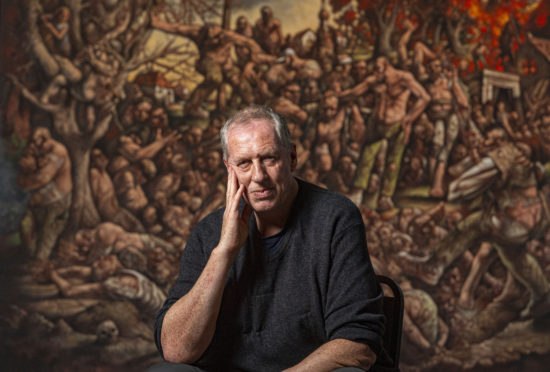
Artist Peter Howson has unveiled a new painting at Glasgow’s St Mungo Museum of Religious Life and Art, commemorating the forthcoming anniversary of the Srebrenica massacre.
The painting, which is on loan to Glasgow Museums for an initial three year period, is a large-scale scene portraying the religious and ethnic conflicts in Bosnia and Kosovo in the 1990s.
The massacre, in which over 8,000 people were killed, was the worst atrocity on European soil since the Second World War.
Howson was commissioned by the Imperial War Museum to record the conflict in the former Yugoslavia in 1992, and a year later he was appointed official British war artist for Bosnia.
This experience had a profound impact on the artist, and the need to commemorate the forthcoming 25th anniversary of the Srebrenica Massacre was the catalyst for creating this new piece specifically for St Mungo Museum.
A second work by Howson, Homeless Jesus 2018, will also go on show. The piece was painte in response to a cast of the sculpture of the same name by Canadian sculptor Timothy Schmalz, which was installed outside St Georges’ Tron Parish Church, Glasgow in December 2017.
Often referred to as one of the ‘New Glasgow Boys’, Howson has established a formidable reputation as one of his generation’s leading figurative painters and is renowned for his penetrating insight into the human condition.
The debut of his latest canvas is a highlight in a wider programme of commemorations taking place across Glasgow and beyond in 2020 to commemorate the 1995 Srebrenica genocide.
Over 8,000 Muslim men and boys were systematically murdered by Bosnian Serb armed forces at the height of the Bosnian war and under the command of Ratko Mladic, who was sentenced to life imprisonment in 2017 for his role at Srebrenica.
Overseeing the installation of the new work, Howson said: “It is difficult to put into words the horror of the massacre of over 8,000 men and boys in the town of Srebrenica during the Bosnian civil war. I was there as a war artist during this time and witnessed what I can only describe as hell on earth.
“The experience caused me many years of illness and the breakup of my family. I still have memories too painful to talk about, but I find that painting these terrible events helps me to try and understand why we do such evil things to each other.
“This painting records a moment in European history; a memory in my mind’s eye of what happened that day.”
Harry Dunlop, Learning and Access Curator with Glasgow Museums, who worked with Howson’s team to bring the artwork to St Mungo Museum said: “War and persecution motivated by religious and ethnic hatred continues to force hundreds of thousands of people from their homelands.
“St Mungo Museum’s founding principle is to further understanding and respect between people of different faiths and those of none. We are hugely indebted to Peter Howson for loaning this extremely powerful and challenging painting to Glasgow Museums.
“It hangs in St Mungo’s most prominent space because we hope it, together with other works on show, will raise awareness of the need to recognise prejudice, extremism and exclusion and the hatred it creates, and ultimately take action to end it.”
Throughout his career, Howson has interwoven themes of conflict and destruction, human suffering and redemption in his imaginative portrayals of contemporary British society.
Strongly influenced by witnessing the brutal and personally harrowing realities of combat as an official war artist, Howson’s paintings have since been founded on increasingly nightmarish visions of chaos and atrocity, and populated by a cast of fantastic, grotesque characters.
He said: “The painting portrays people who are dead and people, many of whom are young boys, ready to die. I tried to capture the fear on their faces and the twisting contortions of bodies awaiting execution with a bullet. Very little film of the prelude to death is recorded. It would have been different if it happened today in the age of the smartphone.
“The perpetrators show no emotion, just a will to get the job done. The beauty of the countryside is a chilling juxtaposition to the horror of the scene. The whole thing is witnessed by a little girl who has climbed a tree. There is not much more you can say. Did the soldiers really believe they were pleasing their God by doing this?”
The new artworks will strengthen the school and public learning programme offered at St Mungo Museum, which often works in partnership with other faith communities to look issues related to religion, including sectarianism in Glasgow, the Holocaust and religious and ethnically motivated violence.
They will also add to a growing collection that represents the experiences of modern migration to the city, which is represented in the recent New Scots display opened in 2018, which features a diverse range of objects from ‘New Scots’ communities from places of conflict, including Iran, Iraq, Syria and Libya.
Harry Dunlop added: “Peter’s work is difficult to look at, but that is the point of having it at St Mungos. We must continue to learn from past atrocities and ensure younger generations know how to recognise the signs of intolerance and the violence it generates wherever in the world it occurs and take action to stop it.”
The Massacre of Srebrenica and Homeless Jesus are now on show at St Mungo Museum of Religious Life and Art. Visit www.glasgowmuseum.com

Enjoy the convenience of having The Sunday Post delivered as a digital ePaper straight to your smartphone, tablet or computer.
Subscribe for only £5.49 a month and enjoy all the benefits of the printed paper as a digital replica.
Subscribe © Bill Murray/ SNS Group
© Bill Murray/ SNS Group